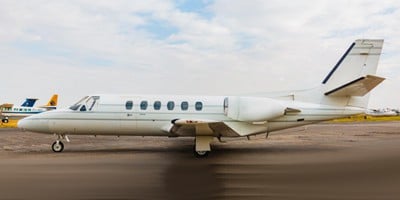
Cessna Citation IISP
The Cessna Citation IISP model 551 series is a light twin-turbofan business jet produced by Cessna from 1978 until 2006. Model 551 seats up to 9 passengers and 1 pilot.
Specifications
Exterior Dimensions
Wing span: 52 ft 2 in
Length: 47 ft 2 in
Height: 15 ft 0 in
Interior Dimensions
Cabin Volume: 292 cu. ft.
Internal Baggage: 36 cu. ft.
External Baggage: 41 cu. ft.
Standard Avionics
Dual Collins Proline, RVSM, TAWS B, ADS-B
Engine
Manufacturer: Pratt & Whitney
Model: JT15D-4
Horsepower: 2500 lbf
Overhaul (HT): 3500 TBO
Performance
| Horsepower: 2500.00 | Gross Weight: 12,500 |
| Top Speed: | Empty Weight: 7,181 |
| Cruise Speed: 385 | Fuel Capacity: 5;009 |
| Stall Speed (dirty): 82 | Range: 2,104 |
| Rate of Climb: 3,625 | Rate of Climb (One Engine): 1,170 |
| Service Ceiling: 43,000 | Ceiling (One Engine): 27,200 |
| Takeoff | Landing |
| Ground Roll: | Ground Roll |
| Takeoff Roll Over 50 ft: 2,650 | Landing Roll Over 50 ft: 2,210 |
History
The Cessna Citation II (Model 550) series of Citation jets are light corporate jets built by Cessna. Stretched from the Citation I, it was announced in September 1976, first flew on January 31, 1977 was certified in March 1978. The II/SP is a single pilot version.
The stretched Citation was announced in September 1976, it first flew on January 31 1977 and FAA certification was awarded in March 1978, the II/SP is the single pilot version. A total of 688 aircraft were delivered.
Design
When the Citation II debuted in 1977 in the light business jet market, it was one-of-a-kind. It sold 1,000 jets in its first four years on the market and was manufactured for sixteen years, making its Cessna’s best-selling private jet to date. Receiving certification in 1978, the Citation II SP is the single-pilot version of this successful line, created to compete in the turbo-prop market.
At the time of the Citation II release, everyone else in the industry was trying to outdo each other by making the heaviest, most complicated, hard-to-fly jet. The Citation II defied all trends with its simple systems and manufacturing techniques, dramatically reducing operating and purchase costs. Its focus on simplicity and economy was so effective in the air and popular among pilots and jet owners, that it completely reversed jet design trends all over the industry. And with the release of the II-SP, Citation challenged the market in all areas.
Development
The Citation II-SP is a likely candidate among light, private jets. It can carry six, eight, or ten passengers and boasts a high speed cruise of 374 knots. Its two Pratt & Whitney JT15D-4 engines provide 2,500 pounds of thrust each on takeoff, with an inspection interval of 3,500 hours. It climbs quickly at a little more than 3,000 feet per minute and has a maximum service ceiling of 43,000 feet.
As previously mentioned, the Citation is most favored for its straightforward design. This feature is best enjoyed in the cockpit, which Business and Commercial Aviation magazine called the “best human factored cockpit in general aviation” upon the Citation II’s release.
Distinguishing Features
The cockpit boasts 340 degrees visibility, a reduction in noise from earlier models, and simple controls for vital systems like fuel and de-icing. The Citation II-SP’s advantage is it can be flown by a single pilot, greatly reducing travel/operating costs and allowing for more flexibility in flight planning.
The Citation II-SP has very good handling characteristics, due largely to its engineers’ decision to use the straight wing design. Not only does this make the jet less susceptible to Dutch rolls caused by strong gusts, but it also increases the ratio of lift per increment of angle-of-attack, which makes for effortless takeoffs and landings.
Just because the Citation II-SP’s systems are simple does not mean that they are not safe. The Citation II-SP is certified under FAR part 23 airworthiness standards – these standards are mandatory for big airliners like the Boeing 747.
The Citation series was a radical change for the better in the private jet industry. It was so influential that the president of Cessna was awarded the Collier Trophy, a national award that recognizes major achievements in the advancement of aviation.
In short, the Citation II and II-SP did not just beat the competition; they changed the way private jets compete. If their flexibility and economy aren’t enough to make them an attractive option, perhaps looking at the competition will.

